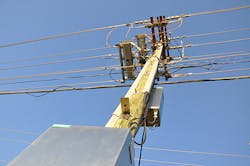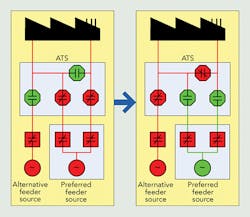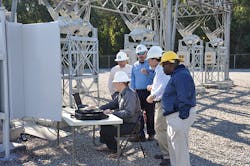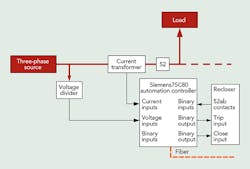The morning shift at a manufacturing facility began as usual on Feb. 18, 2012, with the world’s largest Ibuprofen plant gearing up for another day of all-out production. But at 8:27 a.m., the plant and its more than 300 employees were plunged into sudden darkness. All electric power was lost, production equipment shut down and the reassuring hum of complex manufacturing processes gave way to complete silence.
Almost right away, the emergency generators cranked up, but a return to full production was still some way off as equipment had to begin a slow ramping to restart. Immediately, the economic costs began to mount. But the February outage, which lasted 86 minutes, was not the only one in 2012. Another occurred in April, lasting 61 minutes.
The facility is an anchor of the economy in the Orangeburg, South Carolina, U.S., area. Its 10-MW load is the largest among roughly 25,000 retail customers of the Orangeburg Department of Public Utilities (DPU), which is the largest municipal electric utility in the state.
The Discussion Starts
While the plant was able to shut down with no environmental or safety impacts, the outages created serious production losses and waste generation for the plant. The 2012 outages were not quite the last straw, and the problem was not bad enough for the company to consider relocating operations to a place with more reliable electric service. Instead, a conversation began about improving the reliability of the power feed to the plant.
The team at Orangeburg DPU took the initiative to investigate various options for switching schemes that would reduce or nearly eliminate power outages. After consulting with Electrical Engineering Consulting & Testing (ELECT), it was determined the problem was not with the distribution system; rather, it was with a 46-kV sub-transmission system.
Deciding on Feeder Automation
The Orangeburg DPU team discussed several options to address the problem. The first was a distribution feeder loop automation option, which the team quickly eliminated as being a bad match for the plant’s distribution system, plus it came with costs in excess of US$200,000. The team then considered installing static transfer switches, but cost, again, was found to be an obstacle.
Next, the team looked at a high-speed transfer system of less than 30 msec, such as the ones implemented in Europe using metal-clad switchgear. But the team ruled this out because an outdoor solution was needed.
As discussions continued, the team considered fast bus transfer systems from several manufacturers, but these solutions were too costly to implement. The plant required a transfer to take place in less than six cycles because the facility has a large number of pump motors that drive various processes. The transfer system had to ensure the electrical motors would not de-energize and interrupt production processes.
Orangeburg DPU had an overhead feeder that passed the plant on the opposite side of the road, so the utility decided to use this feeder as an alternative source. System studies confirmed the feeder could support the total plant load and the transfer system, and thus had to support three power sources. The design team investigated and considered various high-speed systems for this application:
• A distribution feeder loop system proved to be beyond budget limitations.
• Static transfer switches proved to be too costly.
• Metal-clad switchgear provided the performance but was also too costly.
Pole-Top Switchgear Solution
Orangeburg DPU decided to deploy a distribution feeder automation-automatic transfer scheme (SDFA-ATS), a high-speed source transfer scheme from Siemens Smart Grid, to improve the reliability to the facility as well as to provide a third alternative power source from another substation.
The solution uses pole-top switchgear, technology that proves very cost-effective and has the ability to expand to multiple (up to eight) sources. Other products currently available could only support two sources at the speed by which the facility needed this to be done. It could only have a very short interruption in supply when the transition takes place. Motor contactors typically open if the loss in supply is longer than 150 msec. Should this happen, the motors driving the facility’s pumps and processes would need to be restarted.
The key factor in making the solution work is Orangeburg had a third source from a feeder coming past the plant and, if needed, it could tap into that and create a fast transfer system using three sources, which would basically solve the problem. This feeder was supplied from a different substation that, in turn, fed from another segment of the transmission system.
Feeder Automation Design and Functions
The feeder automation system consists of four reclosers that act as primary switches and three reclosers connected to the primary three-phase sources. The source voltage is connected to the horizontal bushing (typically used for the load connection on reclosers), which connects to the internal voltage sensors used for voltage monitoring. In addition, the current transformers are connected to the controller, while binary inputs and outputs are used to control the recloser and provide feedback on the recloser status.
The controllers use an undervoltage function to detect the loss of source and are set to trigger if the measured voltage drops below 85% of the specified normal primary voltage. This threshold was decided after simulation of a few scenarios in the computerized model where three 600-hp plant motors can start simultaneously. The recloser controllers are housed in pole-mount control cabinets, one for each recloser, and interconnected with fiber-optic cable that daisy-chains one controller to the next.
From the recloser closest to the substation, fiber-optic cable also was run to the remote terminal unit (RTU) cabinet for supervisory control and data acquisition (SCADA) integration. This substation RTU, using distribution network protocol, polls the controllers for status, alarms and measurements.
Orangeburg also implemented new SCADA screens for this application. The controllers use IEC 61850 generic object-oriented substation event (GOOSE) to communicate peer to peer. The controllers form a decentralized system, thus the system logic is distributed among all devices. Field operator control panels were kept very simple, using switches, push buttons and light-emitting diode (LED) lights for the field operator to interface and control the system.
The system provides three functions:
1. Downstream fault detection. This function must detect a downstream fault and inhibit automatic source transfer sequences. It consists of a special high-speed overcurrent function set to pick up any downstream fault
2. Transmission sag detection. The most common problem in this system is the loss of source from transmission operations and transmission faults feeding the preferred source substation. The system logic initiates a transfer if all sources are depressed, so this could be described as an over-operation. Typically, a transfer would be allowed to transfer to a healthy source only, but for a sag, the voltage can recover in 50 msec to 5 sec. With the system speed, an over-operation provides maximum possible recovery as it is difficult to determine the sag duration time.
3. Sync check. All reclosers in the transfer system perform the sync check before closing to avoid out-of-sync switching. To ensure the sync check will not introduce any additional delay during the operation, logic was implemented to monitor the sync conditions continuously and provide a permanent, permissive close signal if conditions are met and operation is enabled.
The automatic source transfer system also has operational modes implemented to enable and disable automatic operation and allow field operators to locally control the reclosers. The local/remote mode provides the local operator the ability to disable all SCADA commands when local mode is selected. The operator can perform all operations from the control panel in this mode. Auto transfer on/off mode activates or deactivates the automatic transfer system. A simulation mode was implemented to enable the SCADA integration testing to be performed. There is no need to take the transfer system out of service or bypass the reclosers to test status, alarms and controls.
Testing the Power Cycles
Siemens tested the system to perform in less than six cycles from detection of a loss of source to actual closure of the primary contact of the alternative source recloser or reclosers. Lab testing proved the system performed all transfer sequences within the six-cycle time frame. Lab testing also was done by performing secondary injection testing of all sources and currents in all controllers and by monitoring the recloser primary contacts. All possible scenarios were tested to prove reliable operation.
The team from Orangeburg and ELECT then traveled to Siemens for factory acceptance testing of the solution. The actual reclosers and controls used were put together in a test bay at the Siemens plant and put through rigorous test paces to ensure everything was communicating properly and the entire scheme would work.
Installation and Fine-Tuning
After installation, the system experienced its first operation in January 2014. The transmission feed to the preferred source substation was interrupted for more than 300 msec, causing a voltage sag at both preferred source reclosers. The system immediately proceeded to execute the transfer sequence in 225 msec. But the transfer was slower than expected; the connected plant lost several processes during the execution of the transfer sequence. It was determined the transfer system’s downstream fault detection was activated, causing the slow operation. The investigation showed a complete loss of source had caused a sudden current reversal and current increase.
The plant load consists of many lightly loaded motors. When the transmission sag occurred, the motors acted as generation, causing the reversal and sudden increase. To fix the problem, Siemens analyzed data downloaded from all devices and played these back to identical controllers in its test lab. The Siemens team set the downstream fault detection to be less sensitive and, after additional testing, found the setting change resulted in no additional delays. The change was then implemented in the field.
On Feb. 12, 2014, a severe ice storm hit the Orangeburg area, and the system again experienced a complete loss of transmission source at the preferred source substation. But this time, the system executed a successful transfer of a 9-MW load in 90 msec to the alternative source feeder. The sequence consisted of four reclosers operating to transfer the load. As a result, the plant did not experience any process interruptions during the transfer sequence.
Substation Proximity
The estimated cost of enough generation capacity for the entire plant site was estimated to be well above $1 million. The technology created specifically for this project was chosen not only because it worked, but also because it came in at a cost that met expectations. After experiencing the first outage event in January 2014, the team was able to gather a better understanding of the power system dynamics during a loss or sag in transmission power. Numerous subsequent operations proved the speed and reliability of the new pole-top solution.
A low-cost, easy-to-install pole-top application had been realized, integration with SCADA proved successful and, most importantly, a key industrial utility customer was able to count on more reliable power.
It is important to note this new concept of pole-top high-speed source transfer brings into question whether building a substation close to large consumers is the right option. The substation will be subjected to transmission sags that cause process interruptions for the consumers, so it may prove more reliable to provide feeders from different transmission segments as sources with high-speed automation transfer schemes at the consumer site.
John Bagwell ([email protected])is the director of the electric division at Orangeburg DPU. He holds a BSEE degree from Clemson University and has more than 27 years of experience in the distribution and delivery of retail electricity. Bagwell has engineered a nationally recognized system of remote monitoring and control devices for Orangeburg PDU that helps the utility maintain well above-average outage management results.
Mentioned in this article:
ELECT | www.elect-pc.com
Orangeburg DPU | www.orbgdpu.com
Siemens | www.siemens.com




